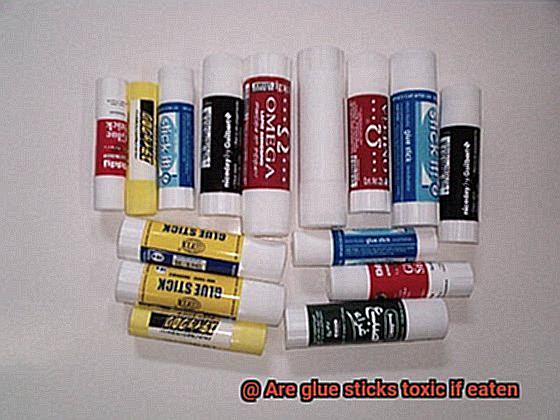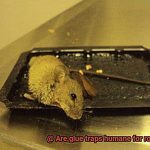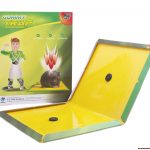Imagine this: You’re in the zone, surrounded by a whirlwind of vibrant papers, markers, and your trusty glue stick. As you dive into your creative project, a nagging thought creeps into your mind: “What if someone accidentally munches on a glue stick? Is it gonna wreak havoc inside?” Well, my friend, let’s peel back the layers of this sticky situation and uncover the truth together.
Glue sticks have become an essential tool in households, classrooms, and art studios alike. They offer a hassle-free way to stick things together, making artsy endeavors a walk in the park. But when it comes to little ones with their curious minds (and sometimes questionable taste buds), concerns about safety arise. So here’s the burning question: are glue sticks truly toxic if swallowed? Can they cause mayhem inside those who dare to take a nibble? Let’s dig into the facts and separate fact from fiction.
What are Glue Sticks?
Contents
- 1 What are Glue Sticks?
- 2 Ingredients in Glue Sticks
- 3 Potential Risks of Eating Glue Sticks
- 4 Symptoms of Gastrointestinal Blockage Caused by Glue Stick Ingestion
- 5 Treatment for Accidental Consumption of Glue Stick
- 6 Additional Chemicals or Additives Found in Glue Sticks
- 7 Prevention Strategies for Keeping Glue Sticks Out of Reach of Children
- 8 Conclusion
With their portable design and mess-free application, these little wonders have revolutionized the way we bond materials together. In this article, we will delve into the fascinating world of glue sticks, exploring their composition, versatility, benefits, and safety considerations.
Composition and Application:
Glue sticks are ingenious creations, housing a solid adhesive substance within a convenient twist-up tube. Crafted from polymer compounds like polyvinyl acetate (PVA), these sticks possess the power to form strong bonds between various materials such as paper, cardboard, fabric, and select plastics. From arts and crafts projects to school assignments and light repairs, glue sticks offer a hassle-free solution for all your bonding needs.
Benefits:
Glue sticks bring a plethora of advantages to the table, starting with their mess-free application. Unlike their liquid counterparts that can drip or spill, these sticks glide effortlessly over surfaces, leaving no sticky residue behind. This not only saves precious time but also makes them an ideal choice for children who can handle them without fear of creating chaos.
Moreover, glue sticks dry quickly, allowing for immediate manipulation or repositioning of bonded materials. This feature proves invaluable when working on time-sensitive projects or requiring the flexibility to adjust items before they become permanently adhered.
Versatility:
Glue sticks are versatile companions in the world of creativity. They seamlessly bond materials together, regardless of whether it’s paper for scrapbooking, fabric for sewing projects, or even plastic for light repairs. With glue sticks in your toolkit, you’ll never be limited by the materials you can work with.

Safety Considerations:
While glue sticks are generally safe when used as intended, it’s crucial to remember that they are not meant for consumption. Made from non-toxic materials like PVA, which are deemed safe for household products like shampoo and toothpaste, glue sticks can still pose health risks if ingested in large quantities or regularly.
The primary concern with ingesting glue sticks is the potential for gastrointestinal blockage. As they are not designed to be digested, glue sticks can form a sticky mass in the digestive system, leading to obstructions. Accidental ingestion is unlikely to cause significant harm, but seeking medical attention is vital if adverse symptoms develop or a larger amount is consumed.
Ingredients in Glue Sticks
Glue sticks, the unsung heroes of the crafting world. They may not have the flashy appeal of glitter or the vibrant colors of paint, but when it comes to getting things to stick together, glue sticks are where it’s at. But have you ever wondered what exactly is in those magical little tubes? And more importantly, what happens if you accidentally swallow a bit?
Let’s start with the basics. Most glue sticks contain a common ingredient called polyvinyl acetate (PVA). Don’t worry, it’s not as scary as it sounds. PVA is just a fancy way of saying synthetic polymer, which gives the glue its adhesive properties. It’s safe and non-toxic, making it perfect for all your crafting adventures.
But what about the other ingredients? Well, water is a big one. It helps keep the glue moist and spreadable, so you can effortlessly stick things together. And since water is pretty harmless, there’s no need to panic if you accidentally ingest a small amount.
Sometimes, glue sticks may also have additives like glycerin or preservatives to prevent them from drying out. These are generally safe too, but it’s always a good idea to check the label for any potential allergens or harmful substances.
Now, let’s talk about the elephant in the room – eating glue sticks. Look, we get it. Glue sticks can be colorful and smell enticing, especially to curious kiddos. But trust us when we say that intentionally ingesting glue sticks is not a good idea. Eating large quantities or doing it regularly can cause digestive issues and discomfort.
Accidentally swallowing a bit of glue stick isn’t likely to cause any major harm. The ingredients are designed to be safe for use on various surfaces and shouldn’t cause any serious problems when ingested in small amounts. However, if you or someone you know accidentally chows down on a significant portion or experiences any adverse reactions, it’s best to seek medical attention just to be safe.
So, as tempting as it may be, let’s keep glue sticks where they belong – in the crafting realm. Always read the labels, follow the instructions, and use them in a well-ventilated area. And most importantly, keep them out of reach of young children to prevent any accidental ingestion.
Potential Risks of Eating Glue Sticks
While it may seem like a trivial topic, it is essential to address the dangers associated with ingesting these adhesive wonders. So, let’s delve into the sticky truth and discover why it is crucial to keep glue sticks away from hungry mouths.

The Choking Hazard:
First and foremost, it is vital to recognize that glue sticks are not meant to be consumed. Their sticky texture poses a significant risk of getting lodged in the throat, leading to a choking hazard. This danger is particularly high for children who might mistake a glue stick for a delectable treat. To ensure safety, let’s keep these marvels out of their reach, reserving them solely for their intended purpose.

Chemicals of Concern:
While most glue sticks contain non-toxic ingredients like polyvinyl acetate (PVA) and water, some may harbor chemicals that could be harmful if ingested excessively. Methanol is one such chemical that can cause symptoms such as dizziness, headaches, and even organ damage when consumed in significant quantities. However, the levels of methanol in glue sticks are generally low and unlikely to cause serious harm unless consumed excessively.
Digestive Discomfort:
Another compound commonly found in glue sticks is polyvinyl alcohol (PVA). Although PVA is generally safe, consuming large amounts of it can result in digestive issues like stomach discomfort, nausea, or diarrhea. It is crucial to remember that glue sticks are not food and should never be treated as such.
Individual Susceptibility:
It is important to acknowledge that certain individuals may be more susceptible than others to adverse reactions from ingesting glue sticks. Children, especially young ones, have a higher likelihood of swallowing small objects like glue sticks accidentally. Additionally, individuals with specific medical conditions or compromised immune systems may experience more severe reactions if they consume glue sticks.
Prevention is Key:
To avoid any potential risks, prevention is key. Keep glue sticks out of reach of children and educate them about the importance of not consuming these items. Proper supervision is necessary, particularly during craft activities involving glue sticks. By adhering to these simple precautions, we can minimize the chances of accidental ingestion.
In Case of Ingestion:
In the event that someone accidentally ingests a small amount of glue stick, they may experience minor discomfort or an upset stomach. In such cases, it is often recommended to drink plenty of water or milk to dilute the glue stick residue and alleviate any potential irritation. However, if a large amount is consumed or severe symptoms occur, immediate medical attention should be sought.
Conclusion:
In conclusion, while glue sticks may appear harmless at first glance, intentional consumption can pose potential risks to our health. The choking hazard and the potential for digestive issues are crucial factors to consider. By keeping glue sticks away from children and using them solely for their intended purpose, we can ensure their safety and enjoy their adhesive powers responsibly.
Symptoms of Gastrointestinal Blockage Caused by Glue Stick Ingestion
From excruciating abdominal pain to potential life-threatening complications, we’ll discuss the symptoms of gastrointestinal blockage caused by glue stick ingestion. So, buckle up and prepare yourself for a sticky situation.
Abdominal Pain:
One of the initial signs of gastrointestinal blockage is a relentless and gnawing abdominal pain. This pain grips your insides like a vice, causing sharp cramps that radiate throughout your belly. It’s as if your stomach is caught in a sticky trap, unable to escape the clutches of glue stick-induced blockage. Along with the pain, you may experience bloating and a pervasive feeling of fullness.
Nausea and Vomiting:
As the glue stick obstruction persists, your body’s defense mechanisms kick into high gear. Nausea rolls over you in waves, making you feel queasy and unsettled. Your body recognizes the presence of a foreign invader and tries its best to expel it through vomiting. However, if the glue stick has solidified, it becomes an unwelcome tenant in your digestive system, leading to persistent bouts of nausea that offer no relief.
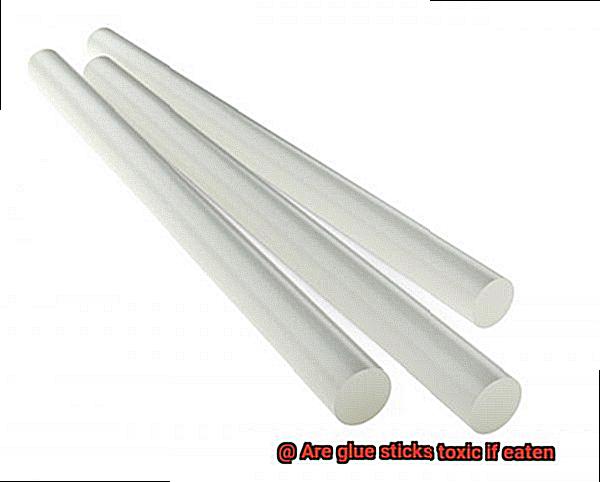
Difficulty Swallowing:
Imagine feeling like your throat has been transformed into a sticky web, trapping anything that dares to pass through. This is what it feels like when a glue stick becomes lodged in your esophagus. It’s as if each swallow is a fight against an adhesive enemy, causing discomfort and making eating or drinking a formidable challenge. Don’t underestimate this symptom, as it can escalate over time and lead to further complications.
Changes in Bowel Movements:
Gastrointestinal blockage caused by glue stick ingestion wreaks havoc on your bowels. The solidified glue acts as an impassable barricade, disrupting the normal flow of stool through your intestines. This blockade can result in constipation, leaving you with painful and infrequent trips to the bathroom. On the other hand, some unfortunate individuals may experience explosive bouts of diarrhea as their body desperately tries to flush out the foreign invader.
Potential Risks and Complications:
If left untreated, gastrointestinal blockage caused by glue stick ingestion can lead to a sticky mess of severe symptoms and life-threatening complications, such as:
- Persistent abdominal pain that refuses to subside, tormenting you day and night.
- A fever that seizes your body, indicating that the glue stick obstruction has caused inflammation or infection.
- Dehydration, as your body struggles to absorb vital fluids due to the blockade.
- The ultimate nightmare: perforation of the digestive tract, where the unyielding glue stick penetrates your fragile tissues, causing severe pain and potentially life-threatening consequences.

Treatment for Accidental Consumption of Glue Stick
Accidental consumption of a glue stick can be a sticky situation, but fear not. With the right treatment, you can navigate this challenge and ensure the well-being of those involved. The severity of the situation depends on the type of glue stick ingested and the symptoms experienced. Let’s dive into the treatment options and steps to take in case of accidental consumption.
First and foremost, if a small amount of non-toxic glue stick is ingested, there is typically no need to panic. In most cases, it is considered safe and does not require medical treatment. However, it is important to keep a close eye on any discomfort or distress that may arise.
On the other hand, if a large amount of glue stick is ingested or if it contains toxic ingredients, immediate action is necessary. Here are some steps to follow:
Stay calm and assess the situation. Is the person experiencing difficulty breathing, severe abdominal pain, or loss of consciousness? If yes, call emergency services immediately.
If the person appears stable and only ingested a small amount of non-toxic glue stick, monitor their symptoms closely for any signs of discomfort or distress.
Provide them with water or milk to dilute the glue and encourage fluid intake. Hydration is key.
Avoid inducing vomiting unless advised by a healthcare professional. Some glues can cause further damage if regurgitated.
If the glue stick contains toxic ingredients or if symptoms like nausea, vomiting, diarrhea, or dizziness occur, seek immediate medical attention.
When seeking medical help, be sure to inform healthcare professionals about the type of glue stick ingested and any specific ingredients mentioned on the packaging. This information will assist them in determining the best course of treatment based on the individual’s symptoms and condition.
Treatment may include supportive care such as intravenous fluids to prevent dehydration or administration of activated charcoal to absorb toxins. In some cases, specific antidotes may be available. For more serious cases, hospitalization and close monitoring might be necessary until the person’s condition stabilizes.
Additional Chemicals or Additives Found in Glue Sticks
Glue sticks, those trusty adhesive companions we rely on for our craft projects, are more than just sticky substances. They contain a fascinating blend of additional chemicals and additives that contribute to their texture, ease of use, and longevity. Let’s take a closer look at the intriguing world of glue stick ingredients.
Polyvinyl alcohol (PVA) is a common ingredient found in glue sticks. This water-soluble polymer serves as a binder, holding all the other components together. Thanks to PVA, glue sticks glide smoothly and effortlessly across surfaces, making them a joy to use.
Another handy ingredient in glue sticks is propylene glycol. Don’t be intimidated by the fancy name; propylene glycol is actually quite common in many products, including cosmetics and even food. In glue sticks, it acts as a humectant, preventing the glue from drying out too quickly. So you can keep sticking without worrying about your glue stick turning into a desert.
Preservatives play a crucial role in ensuring that mold or bacteria don’t make themselves at home in your glue stick. Methylisothiazolinone and benzisothiazolinone are two common preservatives with antimicrobial properties that keep your glue stick fresh for longer. These little helpers work their magic, just like the preservatives in your favorite skincare products, extending the shelf life of your adhesive companion.
And let’s not forget about the fun part – colors. Some brands add colorants or dyes to their glue sticks to give them a vibrant appearance. Rest assured, these colorants are typically safe for use in food or cosmetics. However, it’s important not to mistake them for candy and indulge in excessive ingestion, as it could lead to some colorful consequences.
While most glue sticks are designed to be non-toxic when used as directed, they are definitely not meant for consumption. Ingesting glue sticks, even in small amounts, can pose health risks. So, my crafty friends, let’s keep the glue sticks on our projects and out of our mouths.
Prevention Strategies for Keeping Glue Sticks Out of Reach of Children
Glue sticks are a common and convenient tool for crafts and projects. However, they can pose a potential hazard if they end up in the hands of young children. In this blog post, we will explore effective prevention strategies to keep glue sticks out of reach of children and ensure their safety.
Storing Glue Sticks:
- Secure storage: Store glue sticks in locked cabinets or on high shelves, out of the reach of curious little fingers.
- Child-resistant caps or containers: Choose glue sticks with child-resistant caps or transfer them into childproof containers for added protection.
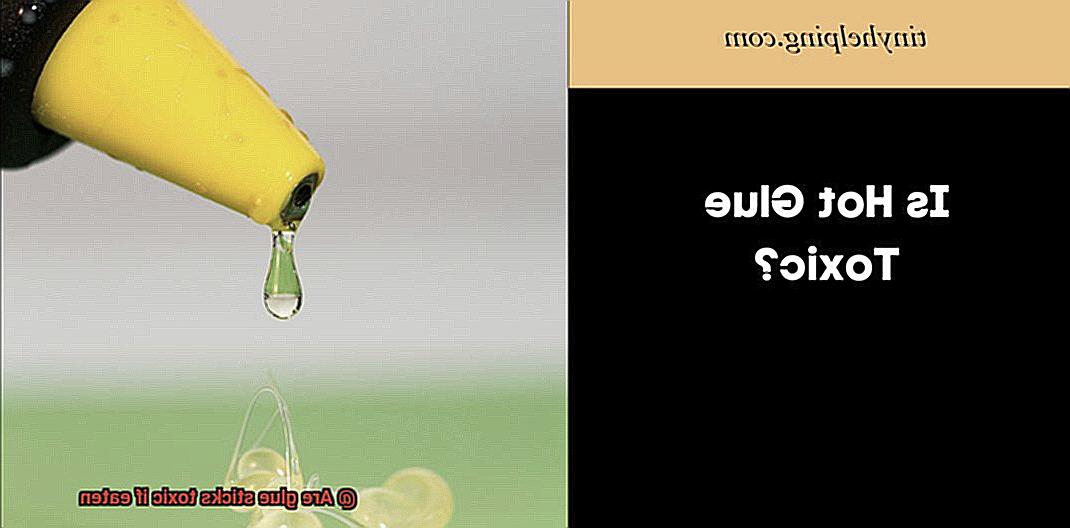
Education and Supervision:
- Teach about the dangers: Educate children about the importance of not putting non-food items in their mouths, including glue sticks.
- Close supervision: Always closely supervise children when they are using glue sticks, especially younger ones who may be more prone to exploring with their mouths.
Regular Inspections:
Check the surroundings: Regularly inspect the environment for misplaced glue sticks that may have been left unattended.
In Case of Accidental Ingestion:
Seek medical attention: While most glue sticks are non-toxic, it is better to be safe than sorry. Consult a healthcare professional if accidental ingestion occurs.

Promoting Safe Alternatives:
Provide safe activities and toys: Encourage children to engage in activities and play with toys specifically designed for their age group, diverting their attention from potentially harmful substances like glue sticks.
fbnYM1pmdto” >
Also Read: Is Hot Glue Toxic? – Glue Things
Conclusion
In conclusion, it is crucial to understand that glue sticks are indeed toxic if consumed.
The chemicals present in these adhesive products can be harmful to the human body when ingested. It is important to keep them out of reach of children and ensure proper storage to prevent any accidents or mishaps.
Remember, prevention is always better than cure when it comes to dealing with potential dangers like glue stick ingestion.

